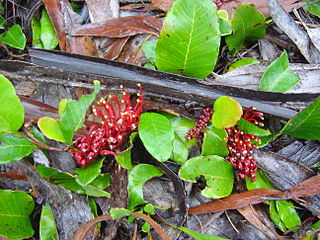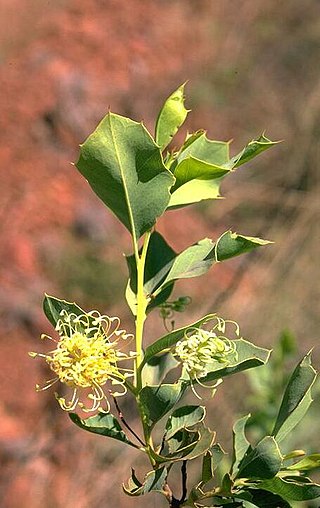
Grevillea sericea, commonly known as the pink spider flower, is a species of flowering plant in the family Proteaceae and is endemic to New South Wales. It is a shrub with elliptic to lance-shaped leaves with the narrower end towards the base, and clusters of usually pink flowers arranged on one side of a flowering rachis.

Grevillea pteridifolia is a species of flowering plant in the family Proteaceae and is endemic to northern Australia. It is also known by many common names, including golden grevillea, silky grevillea, fern-leaved grevillea, golden parrot tree, golden tree, manbulu, yawuny and tjummula. It is a shrub or tree usually with pinnatisect leaves, and bright orange-yellow or reddish flowers.

Grevillea laurifolia, commonly known as laurel-leaf grevillea, is a species of flowering plant in the family Proteaceae and is endemic to New South Wales. It is a prostrate, trailing shrub with egg-shaped, heart-shaped or round leaves, and clusters of reddish to deep maroon flowers.

Grevillea tripartita is species of flowering plant in the family Proteaceae and is endemic to the south-west of Western Australia. It is an erect, prickly shrub with divided leaves with 3 lobes, and clusters of red and cream-coloured or reddish-orange and yellow flowers.

Grevillea monslacana, commonly known as Lake Mountain grevillea, is a species of flowering plant in the family Proteaceae and is endemic to mountainous areas of eastern Victoria in Australia. It is a spreading to erect shrub with narrowly egg-shaped leaves and clusters of pink to reddish pink flowers.

Grevillea bemboka is a species of flowering plant in the family Proteaceae and is endemic to a restricted area of far south-eastern New South Wales. It is a spreading to erect shrub with hairy branchlets, egg-shaped to elliptic leaves and red or reddish-pink flowers.

Grevillea sessilis is a species of flowering plant in the family Proteaceae and is endemic to north-eastern Queensland. It is a shrub or small tree with divided leaves and cylindrical clusters of white flowers with a creamy-white or greenish yellow style.
Grevillea brevis is a species of flowering plant in the family Proteaceae and is endemic to the Northern Territory. It is an erect, open shrub with elliptic leaves and white to yellow or creamy-green flowers.
Grevillea glabrescens is a species of flowering plant in the family Proteaceae and is endemic to the Northern Territory. It is an open, erect shrub with oblong leaves that have triangular teeth or lobes on the edges, and clusters of white to cream-coloured or very pale yellow flowers.

Grevillea byrnesii is a species of flowering plant in the family Proteaceae and is endemic to north-western Australia. It is a shrub with broadly egg-shaped leaves and orange flowers.
Grevillea longicuspis is a species of flowering plant in the family Proteaceae and is endemic to a small area of the Northern Territory in Australia. It is a shrub with divided leaves that are egg-shaped in outline with sharply-pointed teeth or lobes, and clusters of red flowers with a red or creamy pink style.

Grevillea mimosoides, commonly known as caustic bush, is a species of flowering plant in the family Proteaceae and is endemic to northern Australia. It is a shrub or small tree with curved, narrowly elliptic or egg-shaped leaves and greenish-white to cream-coloured or pale yellow flowers.

Grevillea calliantha, commonly known as Foote's grevillea, Cataby grevillea or black magic grevillea, is a species of flowering plant in the family Proteaceae and is endemic to a restricted part of the south-west of Western Australia. It is a spreading, compact shrub with pinnatipartite leaves with linear lobes, and pale yellow to apricot-coloured flowers with a maroon-black to reddish style.

Grevillea oligantha is a species of flowering plant in the family Proteaceae and is endemic to southern Western Australia. It is dense shrub with many erect branches, egg-shaped, lance-shaped or linear leaves, and groups of up to six brownish-yellow, orange or reddish-brown flowers with a pale yellow to reddish style.

Grevillea prasina is a species of flowering plant in the family Proteaceae and is endemic to north-western Australia. It is a spreading or straggly shrub with egg-shaped to elliptic leaves with coarsely-toothed edges, and dense, cream-coloured to pale yellow flowers, the style pale green to white.

Grevillea pyramidalis, commonly known as the caustic bush, is a species of flowering plant in the family Proteaceae and is endemic to north-western Australia. It is an erect, spindly shrub or small tree with simple linear or pinnatisect leaves with linear to narrowly egg-shaped lobes, and white to yellow or cream-coloured flowers.

Grevillea uniformis is species of flowering plant in the family Proteaceae and is endemic to the south-west of Western Australia. It is a shrub with broadly egg-shaped to fan-shaped leaves with sharply tipped teeth or lobes, and more or less spherical clusters of white flowers.

Grevillea variifolia, commonly known as the Cape Range grevillea, is species of flowering plant in the family Proteaceae and is endemic to the far west of Western Australia. It is a spreading to sprawling, irregularly-branched shrub, with broadly egg-shaped to trowel-shaped leaves usually with 3 to 7 teeth or lobes, and down-turned clusters of red flowers with a yellow-tipped style.

Grevillea pluricaulis is a species of flowering plant in the family Proteaceae and is endemic the Northern Territory in Australia. It is an erect shrub with elliptic leaves, the edges wavy, and light green to apricot-coloured or creamy brown flowers with a pale orange-apricot to pink style.

Grevillea pungens, also known as flame grevillea, is a species of flowering plant in the family Proteaceae and is endemic to the Northern Territory in Australia. It is a shrub with egg-shaped leaves with rigid, sharply-pointed teeth or lobes, and hairy, deep pink to orange flowers.
















